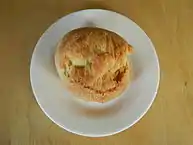Pandesal
Pandesal or pan de sal (Filipino and Spanish for "salt bread"),[1] is a common bread roll in the Philippines. It is made of flour, eggs, yeast, sugar and salt.[2][3]
_02.jpg.webp) .jpg.webp) | |
| Type | Bread |
|---|---|
| Course | Breakfast |
| Place of origin | Philippines |
| Main ingredients | Flour, eggs, yeast, sugar, salt, milk |
Description
Pan de sal is a popular yeast-raised bread in the Philippines. Individual loaves are shaped by rolling the dough into long logs (bastón, Spanish for "stick") which are rolled in fine bread crumbs. These are then portioned, allowed to rise, and baked.
It is most commonly served hot and may be eaten as is, or dipped in coffee, tsokolate (hot chocolate), or milk. It can also be complemented with butter, margarine, cheese, jam, peanut butter, chocolate spread, or other fillings like eggs, sardines and meat.
Its taste and texture closely resemble those of the Puerto Rican bread pan de agua, French baguette, and Mexican bolillos. Contrary to its name, pan de sal tastes slightly sweet rather than salty. Most bakeries bake pandesal in the morning for breakfast consumption, though some bake pandesal the whole day.[4][5]
Variants
A soft yellowish version of pandesal that uses butter or margarine is known as Spanish bread. This variant commonly has sweet fillings.[6]
Some pandesal in supermarkets and in some bakeries are less crusty and lighter in color. They also tend to have more sugar than the traditional pandesal which only has 1.75% sugar.[7]
In Siargao Island, famous as a surfing location, an elongated oval-shaped version of the pandesal is locally known as "pan de surf" due to the similarity of its shape to a surfboard. It is baked on makeshift ovens fueled with coconut husks and usually sold with pan de coco.[8][9]
Dried and ground-up malunggay or moringa leaves are sometimes added to the flour for additional nutritional content; this is called "malunggay pandesal".[7]
A popular new variant of pandesal is ube cheese pandesal which is made with purple yam (ube) with cheese filling. It is characteristically purple like all ube dishes.[10] Other cotemporary variants include addition of chocolate, matcha, strawberry and blueberry flavors.[7]
History
The precursor of pan de sal was pan de suelo ("floor bread"), a local Spanish-Filipino version of the French baguette baked directly on the floor of a wood-fired oven (a pugon). It was made with wheat flour and was harder and crustier than pan de sal. Since wheat is not natively produced in the Philippines, bakers eventually switched to more affordable inferior flour resulting in the softer, doughy texture of pan de sal.[1][11]
Pan de sal flourished during the American colonial era in the early 1900s, when cheaper American wheat became more readily available. It has since become a staple breakfast bread in the Philippines.[1][12]
Baking of pandesal in pugon declined due to a ban on cutting mangrove trees for fuel and bakers shifted into using gas ovens.[7]
Gallery

 Pan de sal plastic-wrapped for the grocers
Pan de sal plastic-wrapped for the grocers Pan de sal with malunggay
Pan de sal with malunggay Pan de sal (lower right) for breakfast
Pan de sal (lower right) for breakfast Traditional full Filipino breakfast with kesong puti, pandesal, sinangag (garlic rice), and a longganisa sausage
Traditional full Filipino breakfast with kesong puti, pandesal, sinangag (garlic rice), and a longganisa sausage
See also
- Pan de monja (Monáy)
- Pan de coco
- Marraqueta
References
- Shah, Khushbu. "How Pandesal Became a Filipino Breakfast Staple". Eater. Retrieved 23 April 2017.
- "Pandesal." Archived February 22, 2014, at the Wayback Machine Pinoyslang.com Archived January 4, 2015, at the Wayback Machine. Accessed July 2011.
- "Pandesal (Filipino Bread Rolls)-The Little Epicurean". 2015-08-20. Retrieved 2016-07-20.
- applepiepatispate.com
- "Pandesal - kawaling pinoy". 2013-12-11. Retrieved 2016-07-20.
- Orillos, Jenny. "Pinoy Bread: 10 Best Panaderia Classics". Spot.ph. Retrieved 1 May 2020.
- Grana, Rhia (18 October 2020). "The rise and rise of flavored pandesal, or how a humble bread became a canvas for Pinoy creativity". ANCX. Retrieved 18 October 2020.
- Catoto, Roel (26 September 2013). "Pan de Surf". MindaNews. Retrieved 28 November 2018.
- "Siargao beyond surfing: A 'Biyahe ni Drew' itinerary". GMA News Online. 24 April 2015. Retrieved 28 November 2018.
- "Ube Cheese Pandesal". Kawaling Pinoy. Retrieved 11 July 2020.
- Estrella, Serna. "The Secret History Behind Pan de Regla and Other Panaderia Eats". Pepper. Retrieved 23 April 2017.
- admin. "Pan de Sal: Philippine National Bread | The Daily Roar". thedailyroar.com. Retrieved 2016-07-20.
